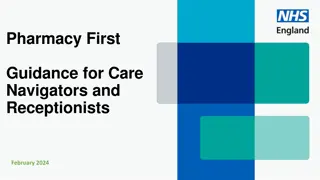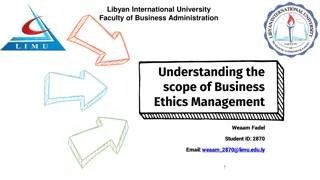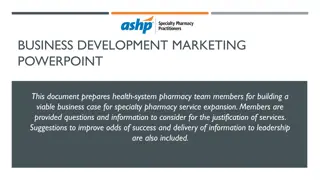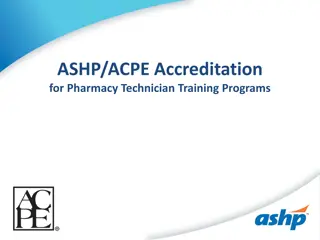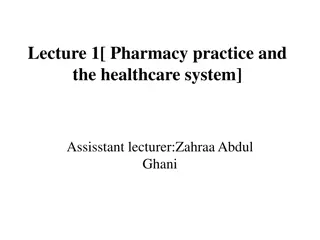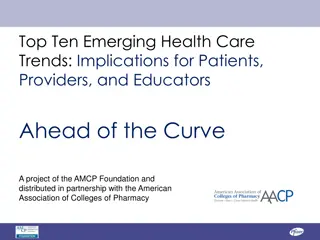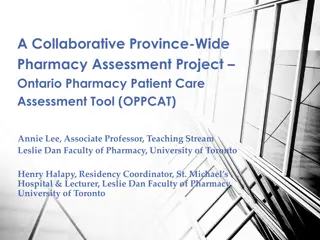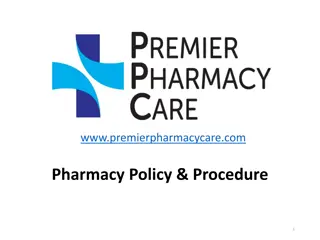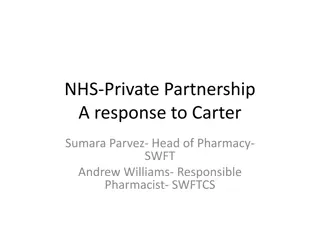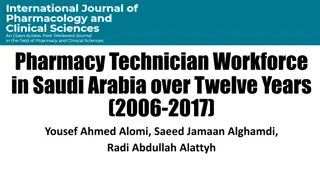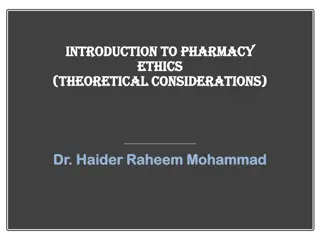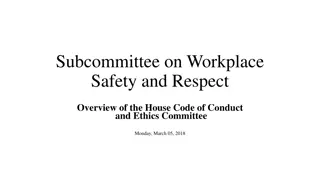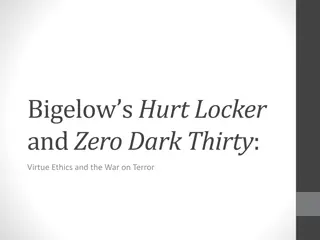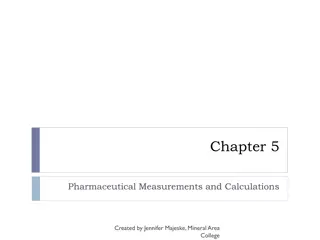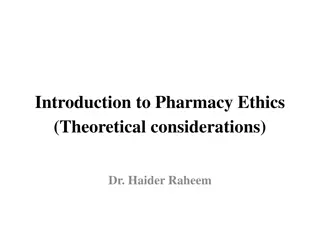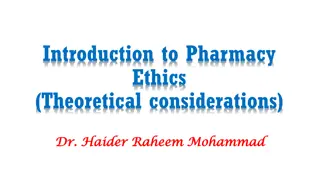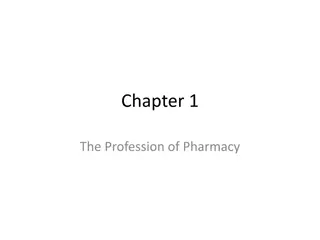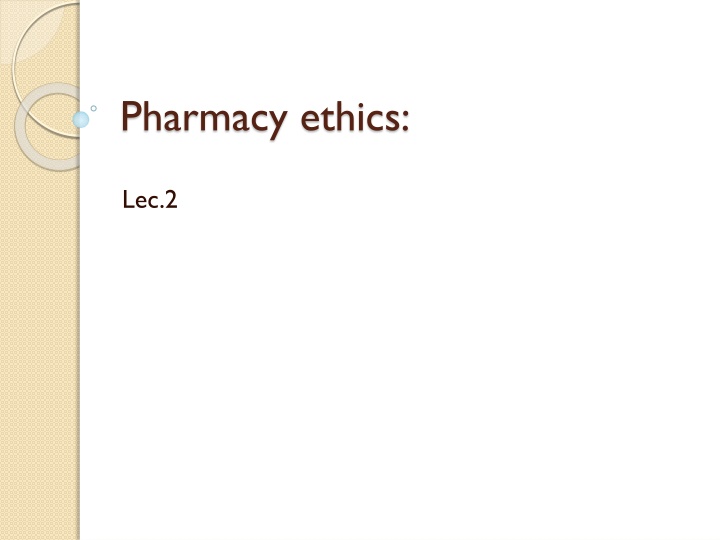
Pharmacy ethics:
Key concepts in pharmacy ethics, including risks associated with new drugs, counterfeit medications, adulteration issues, and misbranding practices. Learn about the dangers of using unapproved color additives and the consequences of distributing adulterated cancer drugs. Understand the significance of proper drug labeling and accurate packaging information to ensure safe and effective medication use.
Download Presentation

Please find below an Image/Link to download the presentation.
The content on the website is provided AS IS for your information and personal use only. It may not be sold, licensed, or shared on other websites without obtaining consent from the author. If you encounter any issues during the download, it is possible that the publisher has removed the file from their server.
You are allowed to download the files provided on this website for personal or commercial use, subject to the condition that they are used lawfully. All files are the property of their respective owners.
The content on the website is provided AS IS for your information and personal use only. It may not be sold, licensed, or shared on other websites without obtaining consent from the author.
E N D
Presentation Transcript
Pharmacy ethics: Lec.2
New drug:any drug its composition is not recognized before by scientific training and safe and effective for use. Color additive: means a material which is a dye, pigment, or other substance made by a process of synthesis or extracted from a vegetable, substance. animal or other
Counterfeit drug: It means a drug which or the container or labeling of which without authorization bears identifying mark of a drug manufacturer or distributer other than the person who is in fact manufactured, processed, packed or distributed. It may: 1- contain inappropriate quantities of active ingredients. 2- it may be improperly processed within the body. (e.g absorption by the body). 3- may contain ingredients that are not on the label 4- may be supplied with inaccurate or fake packaging and labeling. Examples:weight loss drugs,anti-anxiety and anti-depressant. the trademark or other
Adulteration: It refers to: 1- A product that contains filthy, putrid or decomposed substances 2-A product packed under unsanitary conditions 3- A drug product manufacturing process that does not conform to good manufacturing practices. 4- A product that is represented as a drug that is recognized in an official compendium and its characteristics differ from the standards 5- A product that is not represented as a drug in an official compendium and the product differ from the product representation. 6- A product that is combined with an ingredient that reduces the quality or strength of the product. 7- A product contains an unapproved color additive.
One of serious cases of adulterated drug is the distribution of adulterated cancer drugs from foreign countries some shipped in cold packs, were wet and disintegrated upon receipt. Drugs were adulterated methods of storage and shipment were not appropriate and did not provide adequate protection against external factors in storage and use that can cause deterioration or contamination of these drugs. because the
Misbranding: refers to 1- labeling that is false or misleading 2- packaging information regarding the name, place of business, packer or distributor and incorrect statement of quantity of contents in terms of weight,measure or numerical count 3- failing to provide adequate directions for use 4- failing to place prominently so as to be read and understood by an ordinary person that contains incorrect required information
Minimal labeling requirement include the following: 1-The label must not be false or misleading 2-The drug must not be an imitation drug. 3-The drug must not be sold under the name of another drug 4-The packaging and labeling must conform to official compendium standards 5-The product must be labeled appropriately for storage requirements 6-The product must be packaged in childproof containers.
Example: The pain killer Vioxx in 1999 after approval by FDA. The drug was designed to treat osteoarthritis, acute dysmenorrhea. The trouble began when Merck sales reps claiming the drug to treat rheumatoid arthritis. Under the federal law, in order to change or add a new usage for already approved drug, companies applications or submit a new one. Merck did submit an amended application but not until 2001, almost 2 years after marketing Vioxx as a treatment for rheumatoid arthritis. The FDA did not approve it until 2002 .So that from 1999 to 2002, Merck promote and sell a misbranded drug despite an FDA letter of warning issued in 2001. At the same time Merck representative were making misleading statement about Vioxx cardiovascular safety in order to boost the sales. But, in 2004, Merck voluntary pulled Vioxx when a study was halted because of increased risk of heart attacks and strokes in study patients takingVioxx. pain and must amend their original inaccurate, unsupported or
Clinical investigations (phases): Phase1: determines human pharmacological actions: absorption, metabolism, elimination, dosage and side effects. Phase 2: determines the usefulness of the drug or preventing the disease for which the drug product is intended .The no.of patients usually (100-300) participants. Phase III: test the drug for safety and effectiveness (1000-3000) varied geographic areas. participants in
Over the counter: 1- The product manufactured in accordance with good manufacturing practices 2-The manufacturer must be registered. 3-The product must be labeled 4-The label must contain the approved ,established uses 5- advertising must be in compliance with indication and uses 6- Inactive ingredient must be suitable and must not interferes with effectiveness of the product. 7- the label must contain appropriate warning about the unsafe use,side effects and adverse reaction 8- The dosage limitations, maximum daily dose must be established 9- Must contain information about pregnancy and nursing.
Dietary supplement: A product containing one or more of the following dietary ingredients: a mineral, herb or other botanical, amino acid, a dietary substance for use by man to supplement the diet by increasing the total daily intake or a concentrate, metabolite, constituent, extract or combinations of these ingredients. A product intended for ingestion in pill,capsule,tablet or liquid form. A product not represented for use as a conventional food or as a sole item of a meal or diet labeled as a dietary supplement vitamin,
The following structure/function: Claims permissible: 1- Description supplement in affecting the structure or function of the body. That is (calcium supplements with vitamin D for strong bones,helps maintain a healthy heart). 2- Identification of the mechanism utilized by the dietary supplement to maintain structure and function. maintains bowel regularity the role of dietary That is fiber
Drug recall: Removes a prescription or over the counter drug from the market. There are 3 types of recalls: 1- Class I: have a reasonable probability that the use of the product will cause serious adverse health consequences or death. For example; is a label mix up of two potent drugs or a defective replacement of heart valve
2- Class II recall : involves the use of the product or exposure to the product may cause temporary or medically consequences or where probability of serious harm is remote e.g a sub potent drug product 3- Class III recalls:involves the use or exposure to a product that is not likely to cause adverse health consequences e.g inclusion of material not intended for inclusion in the product such as dirt,plastic and animal parts. reversible health
Expiration dating: The date after which the product stability is not guaranteed products must meet standards of identity, strength, quality and purity. Expiration dates may be dependent upon specific storage requirements as specified in the labeling of the product
Beyond use dating: Is used for those products that are changed by the addition of another substance thereby affecting the stability of the product. e.g amoxicillin suspension that is stable for 10 days in the refrigerator.The manufacturer expiration date of the suspension is greater than 10 days; however, the addition of water to the product makes the product unstable after 10 days.
Controlled substance schedules: Schedule I: those drugs with high potential for abuse, with no currently accepted medical use in treatment in the united states and no accepted information on the safety of their use, even under medical supervision e.g opiates;heroin Hallucinogenic substance:lysergic acid Depressants:gamma-hydroxy butyrate
Schedule II: those drugs with a high potential for abuse less than Schedule I, with accepted medical use in treatment in the united states and abuse of the drug may lead to severe psychological dependence e.g: Opiates and opioids (narcotics): codeine, morphine Stimulants:amphetamine Depressants:amobarbital physical or
Schedule III: drugs with abuse potential less than Schedule I and II,with accepted medical use in treatment and abuse of the drug may lead to moderate or low physical dependence or high psychological dependence e.g stimulants, depressants, narcotic, anabolic steroids containing not more than 90 mg of codeine per dosage units
The practice of pharmacy Defined by the laws, rules and regulations established by the federal government. It is referred to as the pharmacist scope of practice.
Pharmacy license: Pharmacy establishment must be licensed. Licenses are obtained from the state board of pharmacy. Each established specific requirement for the operation of a requirement for equipment, staffing and counselling. License for Iraqi pharmacists obtained from the Iraqi syndicate of pharmacists. state has pharmacy with


